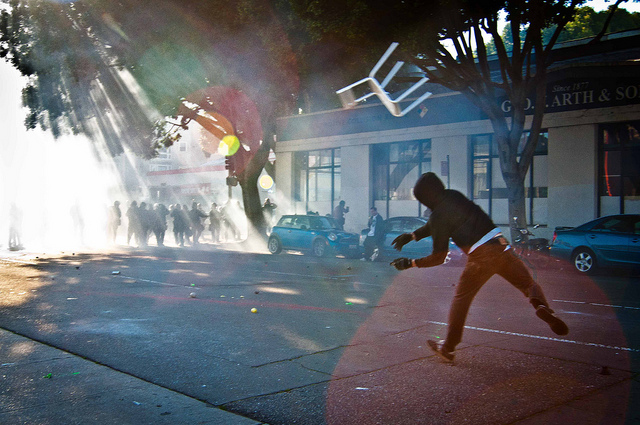
Adapted from the as-yet-unpublished book by the author, Do What Works and Call It Capitalism.
That Improving Economy Is Further Away Than It Appears
Leisure and hospitality – the fastest growing major blue-skill industry – is the worst sector. The average leisure and hospitality worker makes just $18,900 a year (gross, before taxes). This is not even enough to keep a family of three above the poverty level ($19,790 in 2014). Similarly, retail, the largest blue-skill sector, is second-worst in terms of pay, with average annual earnings of $27,700. – Mike Cassidy, Where Are the Jobs? 2015 (1)
By most media accounts, the US economy at the beginning of 2015 is recovering nicely from the Great Recession. GDP is growing at a historically healthy rate, above 2 percent per year. Unemployment is about the historic average, at 5.7 percent. The stock market is near record highs. And more jobs are being created than at any time in more than 10 years. But this is all a great deception. The expansion is benefiting a tiny minority of the population only – the very rich. No one else has any money, and without significant changes in government policies, no one except the wealthy is likely to have any in the future.
This is the fact that eluded the Democrats in the 2014 election. When Democrats boast of how well President Obama has done with the economy despite Republican opposition to everything he does, they are missing the point. This economic resurgence has not reached most Americans.
Ronald Reagan brought supply-side economics to the federal government, the belief that suppliers of goods drive the economy, not the consumers. The supply-siders believe that lower taxes stimulate production and improve the economy. They also favor deregulation of industry. The theory, which acquired the nickname “trickle-down economics,” was that economic growth would benefit everyone. That has not happened. The entire supply-side economic theory has proven to be totally wrong as the data in this article shows.
When George H.W. Bush ran against Reagan for the Republican nomination in 1980, he called Reagan’s supply-side economics, “voodoo economics,” and he was right. It has no basis in reality, but it has bewitched the Republican Party and they still cling to it. And most current government financial policies still are consistent with it. Bill Clinton did not change things. Barack Obama has not changed things. The Reagan economic program still is with us, and still is doing great damage to the US economy and most Americans.
At the beginning of 2015, more than six years since the crisis of 2008, most Americans were either in a worse financial condition than they were before 2008, or had experienced very little improvement in their economic condition. Most Americans have no financial reserves and live paycheck to paycheck.
In January 2015, the Pew Charitable Trusts published “The Precarious State of Family Balance Sheets,” in which the incredible conclusion is reached that virtually no one in the United States has ready cash reserves to cover two months of lost income. Clearly, most of the top 20 percent have other assets, stocks and bonds, real estate etc. on which they can draw, and they seldom lose their jobs without good severance packages. But 80 percent do not have enough reserves to last more than a month, and half of them do not have enough to last two weeks.
Most Americans also do not have much in the way of assets – property or investments. The historic recovery of the stock market from the 2008 crash did not benefit the vast majority of Americans because they don’t own stock. Yes, many do indirectly through 401k mutual funds and pension funds, but those assets cannot easily be converted into cash.
Between the burst of the housing bubble and the huge trade deficit, a trillion dollars has disappeared from the US economy and Americans are not spending enough to make it up.
A substantial portion of the loss of $8 trillion in home equity in the subprime mortgage meltdown has not been recovered, especially for those in less expensive homes, and for the millions forced out of their homes, their losses will never be recovered. The rapid rise in home values in the years prior to the 2008 meltdown was a giant real estate bubble larger than any in the past. People borrowed against their rising home equity, or refinanced and took cash out of their homes. That “bubble economy” generated hundreds of billions of dollars in annual economic activity. When the bubble burst and those home values dropped, those hundreds of billions of dollars vanished from the economy. And they have not been replaced.
At the same time, rising imports and a strong dollar caused a massive trade deficit of $505 billion in 2014. When the US dollar rises in value against other currencies, it makes US products more expensive and imports more competitive. It also reduces the overseas profits of US companies when those profits are converted into dollars.
Compare the loss of approximately $1 trillion in consumer spending annually with the one-time expense of the 2009 Obama stimulus package of $819 billion and it is not hard to see why the recovery from the Great Recession has been so slow, and has reached so few of the people.
The following chart shows the growth in actual dollars of household consumer spending in the United States between 1990 and 2013. There was a steady increase through the 1990s and the total spending increased by $10,000, or 33 percent. In the next five years, when the housing bubble was growing, it increased twice as fast, rising by another $10,000. Then the crash of 2008 occurred and spending dropped. By 2012, consumer spending had returned to the level of 2008, but it dropped slightly in 2013. Consumer household expenditures in 2013 were only about 5 percent higher than they were in 2008.
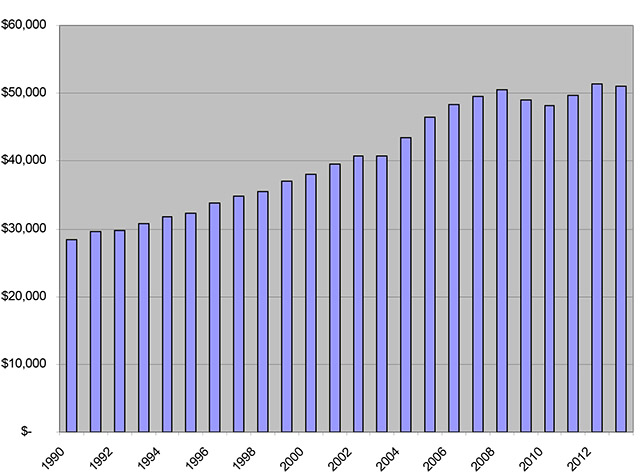 Average Annual Household Expendatures
Average Annual Household Expendatures
There is no recovery of middle class jobs.
And then, to top things off, most of the jobs that have been created since the end of the Great Recession are at the upper levels, where significant education and/or skills are required, or at the lower levels, where the average wages are declining and are at or close to poverty levels. The kinds of good-paying factory jobs that once provided people without college educations a chance at a middle-class life are a small fraction of the jobs being created today.
Many of the people who lost jobs that supported their middle-class lifestyles are now working for much lower wages in service jobs and living in, or close to, poverty. A Federal Reserve study reported that the greatest demand for workers since the Great Recession has been in the poverty-level, minimum wage-paying service industries, and the lowest demand is for midlevel workers who once comprised the vast majority of the middle class. (2)
An April 2014 report (3) by the National Employment Law Project provided details supporting the Federal Reserve study. During the recession, low-wage jobs, those paying less than $27,700 per year, had both the lowest percentage of losses and the highest percentage of gains. Twenty-two percent of the total job losses were in the low-wage category, but 44 percent of new jobs were in that category. Mid-wage jobs, those paying between $27,700 and $41,600, had the lowest percentage of new jobs created, 26 percent, but the second highest rate of job losses, 37 percent. High-wage jobs, those paying more than $41,600, had the highest rate of losses, 41 percent, but a higher rate of new jobs created, 30 percent, than the mid-wage category.
In January 2015, The Century Foundation report, “Where Are the Jobs?,” reinforced those earlier studies. This chart shows the growth of jobs and in each classification indicates the percentage that requires a college education.
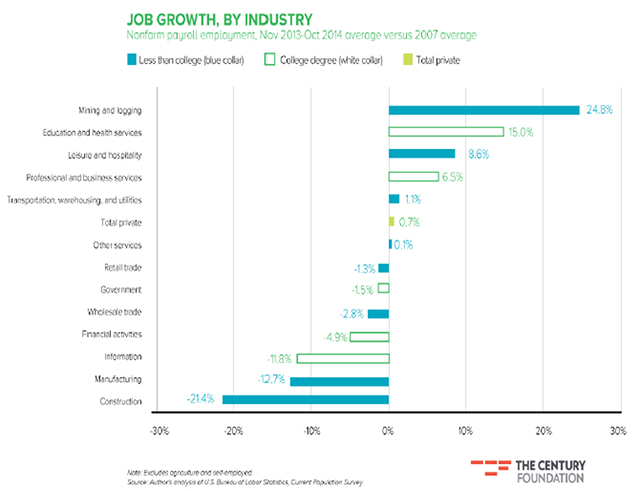
Of the 257,000 jobs in the January 2015 report of jobs created, 22,000 were in manufacturing, but the average for the three previous months was 31,000, still not a great deal. And the total of manufacturing jobs today is only about 10 percent of all jobs.
The most jobs created in any category were in retail, 45,900, the second-lowest paying of all job categories with an average wage of $27,000. Health care and construction each created about 39,000 jobs. The growth of construction jobs is good news for blue-collar people because generally jobs do not require a college degree and the jobs pay well, on average about $54,000. Health-care jobs are mixed between some that require college and some that do not. While health care is a rapidly growing field, wages are not particularly high except for professionals and those with advanced training.
Here are the average wages by job category:

Only about 20 percent of people with jobs are experiencing increases in income.
Even if you were lucky enough to have a good-paying job in 2015, you probably were getting little in the way of pay increases unless you were promoted. Average wages have risen only slightly in recent years, about 2 percent per year in 2013 and 2014, and less than that previously.
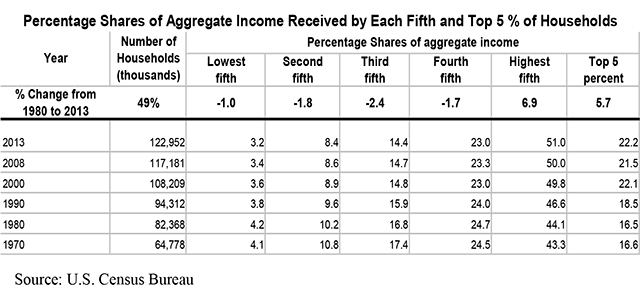
Among households, the only group that has increased its share of national income since 1980 is the top 20 percent. Every other group has experienced a gradual decline. And it can be seen from the following chart that in recent years there has been an acceleration of the increases in the earnings of the top 20 percent. There definitely was a change in income distribution beginning in 1980 when Reagan was elected. Prior to that, as can be seen in the row 1970-1980, the bottom 20 percent received the highest percentage gain in income. Since 1980, the bottom 20 percent have received the lowest percentage increase in income. Under President Obama, they have done particularly poorly, with their average income declining slightly. The chart also shows how much better the top 20 percent have done since 1980 compared to everyone else.
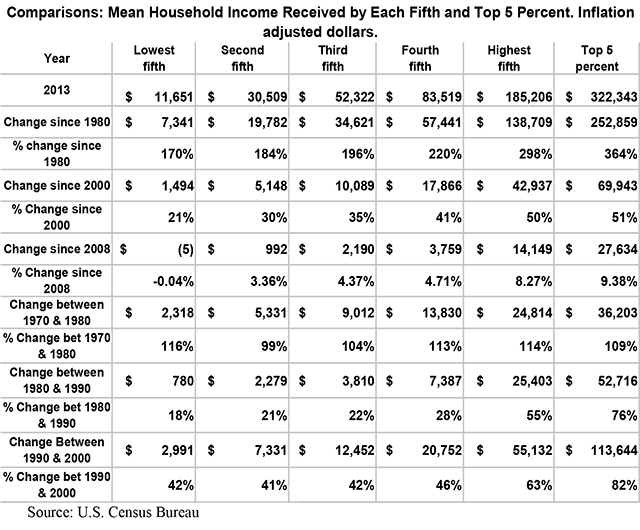
Wages of lower-paid occupations are getting even lower while wages of higher-paid occupations are rising. The Century Foundation reports:
The rich are getting richer. For every $10,000 in additional average weekly earnings an industry had in 2007, its average earnings grew by an extra 2 percentage points during the six-year period. For example, the average employee working in retail, a low-paying industry, earned $28,300 for a full year of work in 2007; after adjusting for inflation, the same employee actually made less, just $27,700, last year. By contrast, the average information worker earned $59,900 in 2007, among the highest of any industry. During the next six years, the advantage of information workers over poorly paid workers only grew, with average earnings increasing 9.4 percent, or $5,600 in real terms. The same is true of other white-collar sectors, like finance (a gain of $4,500) and professional services (a gain of $3,600). Like so many other labor market indicators, this link between earnings and earnings growth reflects rising inequality. (4)
A recent report shows that even the wages of factory workers are declining. And the result of declining wages is increasing poverty. Of the 34 countries in the Organization for Economic Cooperation and Development (OECD), which includes most of the countries in Europe, North and South America, Australia, New Zealand, Japan and South Korea, there are only four that have a higher percentage of their population in poverty than the United States: Chile, Mexico, Turkey and Israel.
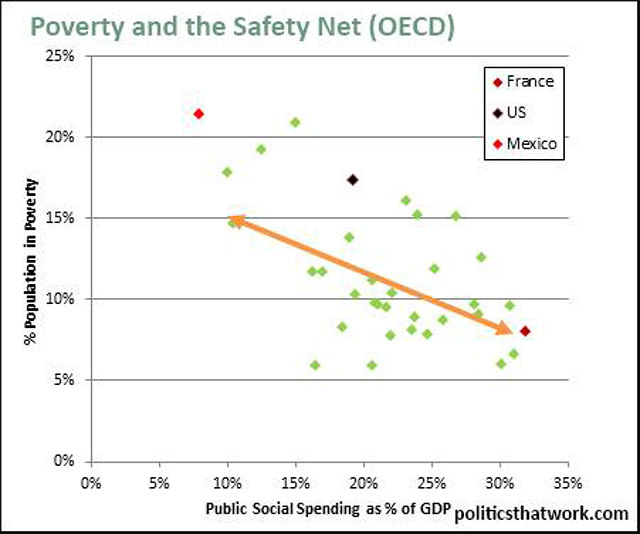
This graph compares the percentage of each country’s population that is living below the poverty line against the percentage of the GDP each country dedicates to public sector social spending. The countries included are all of the members of the OECD.
France (which spends the largest percentage of its GDP on its safety net), Mexico (which spends the smallest percentage) and the United States are specifically marked. The US spends a low percentage of its GDP on its safety net and has a very high percentage of its population living in poverty. (5)
Economic inequality and increasing poverty are direct results of government policies.
There have been a number of policy decisions by the federal government that have had a negative effect on the economy and on average income, resulting in less money being available for consumption, and also increasing poverty. With less money available for consumption, fewer goods are purchased, and fewer jobs are created. And cheaper foreign goods sold by the discount chains have greater appeal.
One of the decisions has been not to increase the minimum wage, nor to index it to inflation. As a result, it has not kept up with inflation, and it has not kept up with productivity. It would be almost $11 an hour now if it had just kept up with inflation. Various calculations have placed between it between $18 and $22 an hour if it had kept up with productivity. While there are only a few million people working at the minimum wage, there are many millions more working at wages not much higher than the minimum. An increase in the minimum wage would push up the income of tens of millions of Americans.
Another decision has been to limit unemployment benefits. Considering that unemployment benefits are mostly paid for by taxes on employers, it is truly outrageous that Congress has limited payments, especially at a time of economic malaise. Every dollar paid in unemployment benefits is plowed back into the economy almost immediately and that has a “multiplier” effect. More money in the economy generates more demand, more production and more jobs. The Department of Labor reported in 2014 that because Congress chose not to extend the expiration times for benefits, only 27 percent of the unemployed were receiving unemployment payments at the end of 2013, a record low.
That we have a dysfunctional Congress has been obvious for some years, especially since the Republicans won control of the House of Representatives in 2010. Now they also have control of the Senate and there is little hope that they will behave responsibly. They are interested only in increasing the wealth of the already wealthy and powerful, and they are willing to do so by further reducing the standards of living of almost everyone else. Here is a graphic showing the impact of conservative policies.
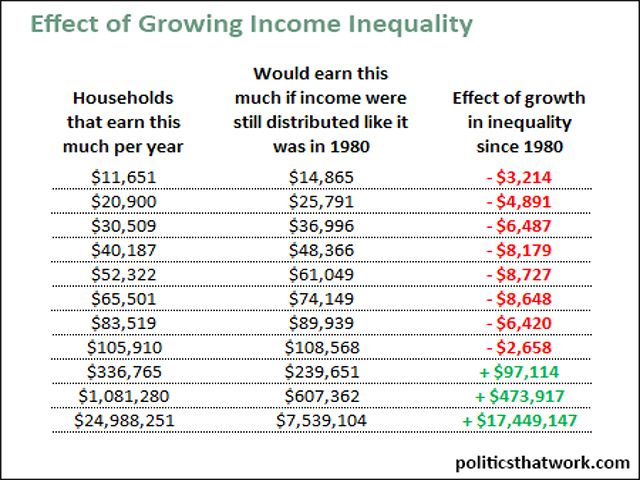
There is redistribution of wealth in the United States. It is being redistributed from the poor and the middle class to the rich.
And because incomes are not rising, most people are not accumulating any wealth. Many have less wealth than they did before the Great Recession. This pie chart shows what has happened to wealth in the United States since Ronald Reagan.

Economist Barry Bluestone, who, with Bennett Harrison, published in 1988, one of the first books harshly critical of Reagan’s economic policies, recently explained on PBS “NewsHour” that supply-side economics redistributes wealth from the middle class and the poor to the wealthy. The problem, he said, is that the wealthy only spend about 30 percent of their income, while everyone else spends nearly all of theirs. Consequently, he said,
… as we move money away from working families towards very wealthy families, we take more and more consumption out of the economy, means slower and slower growth, means higher and higher and extended unemployment.
Emmanuel Saez, professor of economics and director of the Center for Equitable Growth at the University of California, Berkeley, is the acknowledged US expert on economic inequality and the disparities of income and wealth. He and French economist Thomas Piketty have jointly developed enormous databases of changes in income and wealth over time. His graphic of the dramatic increase in the share of income by the top 1% over the past 35 years has become well known. This is the latest version:
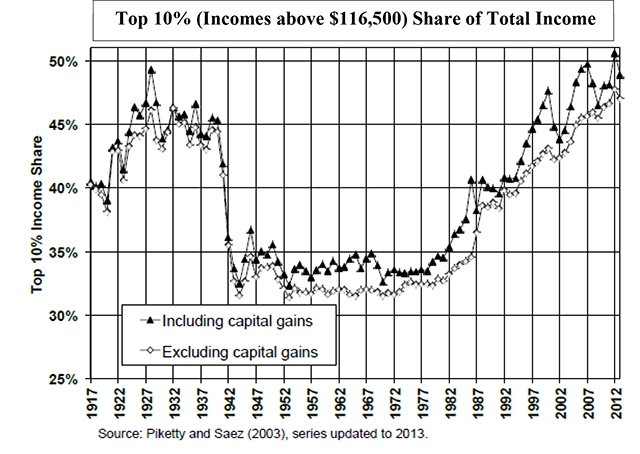
In his January 25, 2015, update, Saez wrote:
The drastic cuts of the federal tax on large estates could certainly accelerate the path toward the reconstitution of the great wealth concentration that existed in the U.S. economy before the Great Depression. The labor market has been creating much more inequality over the last thirty years, with the very top earners capturing a large fraction of macroeconomic productivity gains. A number of factors may help explain this increase in inequality, not only underlying technological changes but also the retreat of institutions developed during the New Deal and World War II – such as progressive tax policies, powerful unions, corporate provision of health and retirement benefits, and changing social norms regarding pay inequality. We need to decide as a society whether this increase in income inequality is efficient and acceptable and, if not, what mix of institutional and tax reforms should be developed to counter it.
Conclusion: The economy could be fixed. Prosperity could be widely shared. Disparities of income and wealth could be diminished. But none of this will happen if Americans keep voting for the Republicans and their failed trickle-down economic policies.
The tragedy for most Americans is that Democratic administrations have not developed new programs to counter the increasing inequality caused by the Reagan economic program. Government policies – including trade deals, cutbacks in education spending, reduced government spending and failure to aggressively attack the economic crisis – have resulted in enormous inequality in the US democracy for which we should be ashamed. Even this past December, Congress repealed one of the Dodd-Frank provisions adopted after the bank crisis of 2008 designed to protect the public from having to pay for bad investments made by banks.
Government policies dictated by Republicans and acquiesced to by Democrats are continuing to help the rich and powerful gain greater wealth and position, while reducing opportunities for education and good jobs for almost everyone else.
Our economic problems could be solved. We could reduce economic inequality. The solutions are well known. We just have not developed the national resolve to solve the major problem: the control of governments at the state and federal levels by those who owe their allegiance to special interests – the wealthy and the big corporations.
The cures to our economic problems are known and could be implemented rapidly if progressives controlled the state and federal governments.
– The minimum wage is far too low, well below the poverty line. Originally, it was intended to be the minimum amount that could provide adequate support. It needs to be increased substantially. A $15 minimum wage would lift millions out of poverty and low-wage jobs, and significantly reduce dependency on food stamps and the earned-income tax credit program, both of which are major subsidies to the giant corporations that don’t pay living wages. The increase in the minimum wage is necessary because most Americans no longer have the bargaining power of unions to help them gain living wages and decent benefits.
– Infrastructure spending creates tens of thousands of good-paying jobs, not only in construction, but also in the entire supply chain. The nation’s highways, bridges and rail systems need modernizing and it is time to do it.
– Restoring the progressive income tax by raising the tax rates on the wealthy back to where there were before Ronald Reagan would generate billions of new government revenue and would help to reduce economic inequality. Increasing taxes on capital gains and estates also would generate additional billions. Taxing Wall Street transactions, particularly derivative transactions, would generate billions more dollars in new revenue.
– Reducing or eliminating the cost of college education would lift the enormous financial burden that people face in trying to obtain the education necessary to earn a decent living in a highly technological world.
– Reducing or forgiving existing college loan debt would generate a burst of economic activity. People would be able to buy homes – and stimulate the economy – if they did not have to pay off enormous student loans.
– Greater government oversight of corporations, including actual enforcement of antitrust laws to break up some of the oligopolies that have formed in many industries, would help to spur more free enterprise, more competition, better service and greater innovation, to say nothing of more jobs. As I proposed in another article, government regulation should be consolidated into one major agency.
– Making it much more difficult and uneconomical for corporations to shift jobs, or their headquarters, out of the country would help to stem the tide of job losses.
– No new trade deals should be permitted that harm US workers or limit the government’s regulatory abilities. Existing trade deals should be renegotiated.
There are more things that government could do to restore the middle class and reduce poverty, but without a change in the political control of the government, nothing is going to happen. Progressives must unite to block efforts at both the federal and state levels to roll back safety net programs, protection of privacy and voting rights, and offer the American people a true choice – a choice between the opportunity for prosperity for everyone, or wealth for a small minority at the cost of the economic security of everyone else.
Footnotes:
1. Mike Cassidy. “Where Are the Jobs?” The Century Foundation, January 2015, https://apps.tcf.org/where-are-the-jobs
2. For a discussion of this subject, with links to various articles, see https://economistsview.typepad.com/economistsview/2013/01/skill-biased-technological-change-and-rising-wage-inequality.html
3. “Data Brief: The Low-Wage Recovery, Industry Employment and Wages Four Years into the Recovery.” New York: National Employment Law Project, April 2014.
4. Cassidy. “Where Are the Jobs?”
5. “Poverty and Social Spending as a Percentage of GDP in the OECD.” https://politicsthatwork.com/graphs/poverty-safety-net
We’re not backing down in the face of Trump’s threats.
As Donald Trump is inaugurated a second time, independent media organizations are faced with urgent mandates: Tell the truth more loudly than ever before. Do that work even as our standard modes of distribution (such as social media platforms) are being manipulated and curtailed by forces of fascist repression and ruthless capitalism. Do that work even as journalism and journalists face targeted attacks, including from the government itself. And do that work in community, never forgetting that we’re not shouting into a faceless void – we’re reaching out to real people amid a life-threatening political climate.
Our task is formidable, and it requires us to ground ourselves in our principles, remind ourselves of our utility, dig in and commit.
As a dizzying number of corporate news organizations – either through need or greed – rush to implement new ways to further monetize their content, and others acquiesce to Trump’s wishes, now is a time for movement media-makers to double down on community-first models.
At Truthout, we are reaffirming our commitments on this front: We won’t run ads or have a paywall because we believe that everyone should have access to information, and that access should exist without barriers and free of distractions from craven corporate interests. We recognize the implications for democracy when information-seekers click a link only to find the article trapped behind a paywall or buried on a page with dozens of invasive ads. The laws of capitalism dictate an unending increase in monetization, and much of the media simply follows those laws. Truthout and many of our peers are dedicating ourselves to following other paths – a commitment which feels vital in a moment when corporations are evermore overtly embedded in government.
Over 80 percent of Truthout‘s funding comes from small individual donations from our community of readers, and the remaining 20 percent comes from a handful of social justice-oriented foundations. Over a third of our total budget is supported by recurring monthly donors, many of whom give because they want to help us keep Truthout barrier-free for everyone.
You can help by giving today. Whether you can make a small monthly donation or a larger gift, Truthout only works with your support.